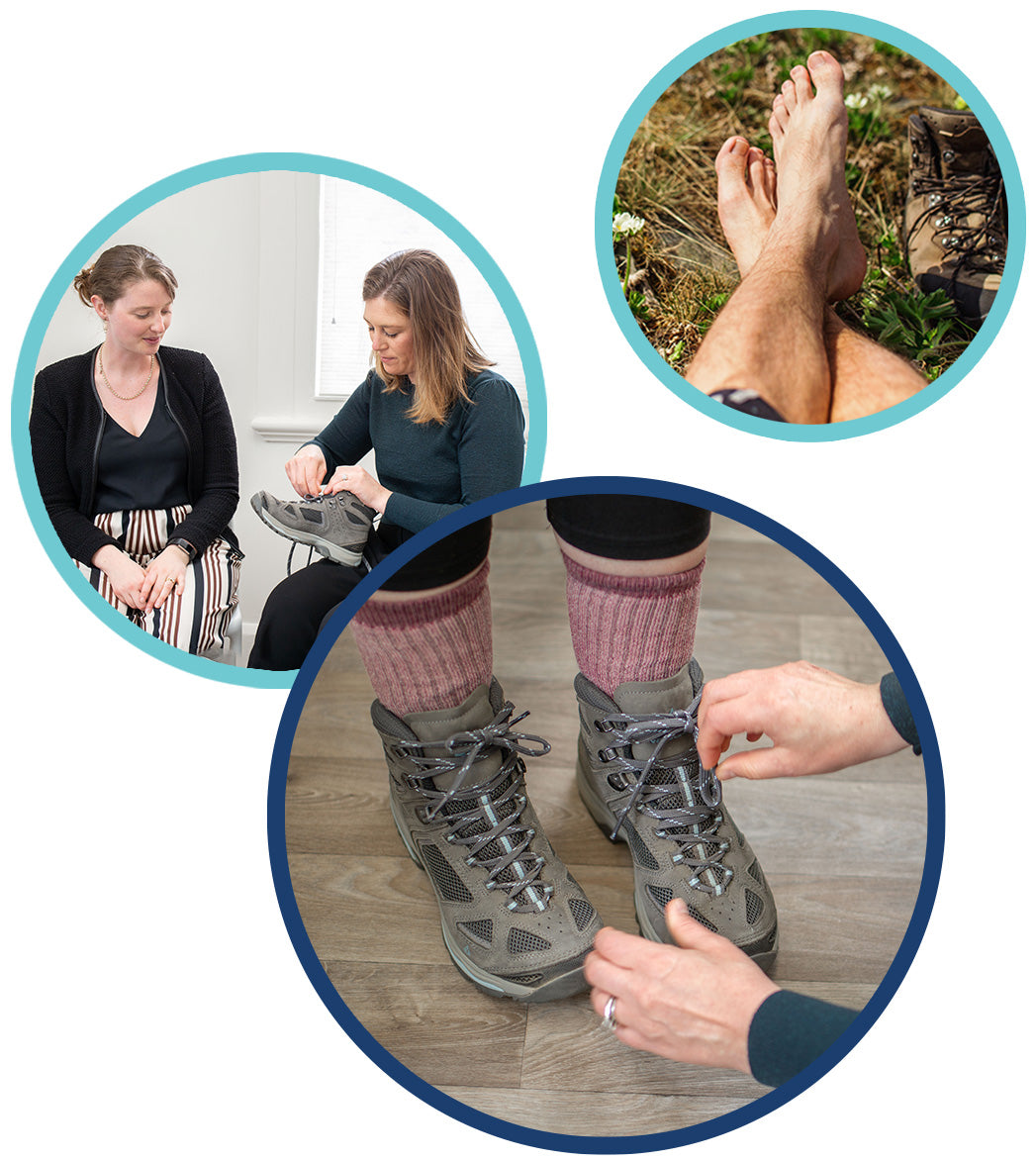Hiking Essentials To Prevent Blisters, Pain & Injury
Our podiatry team loves hiking. And walking in general. It’s fun, you get to enjoy nature, explore new places, it’s great exercise, a fantastic social activity with friends - we could go on and on about the health benefits. So when you’ve planned a hike, it can feel very disheartening to have foot pain put a damper on your day - as well as a damper on your goals, like if you’re entering the Walk1200km challenge - which our Senior Podiatrist, Sophie, was interviewed for to talk about footwear prescriptions - read it here.
Remember: Walking Long Distances Will Always Put Stress And Tension On Your Feet
Before we dive into the things you can be doing and using to help prevent blisters, pain and injury when you’re spending long periods of time on your feet, the first thing that you must remember is that the simple act of a long walk or hike will always place notable stress on your feet and legs. Think about the nature of hiking - uneven trails, rocky paths, and ascents and descents of varying gradients. Even though many of us navigate these (seemingly) seamlessly, it’s because our body and muscles are putting in so much work behind the scenes to support us in being able to do so safely.
Long walks and hikes are a very repetitive activity that is filled with constant flexion and extension of the ankles, knees, and hips - all of which contribute to muscle fatigue and joint strain. The uphill climbs require a fair amount of work on behalf of your calf muscles, quadriceps, and glutes, demanding both strength and endurance. Downhill descents shift the focus to eccentric muscle contractions, particularly in the quadriceps, to control the body's descent and absorb the impact on the joints.
The variability of the terrain adds another layer of complexity to the demands of hiking. Uneven surfaces, such as rocks, roots, and gravel, require constant adjustments in foot placement to maintain stability. This dynamic nature of the trail constantly engages your stabilising muscles throughout the feet and ankles, promoting proprioception and balance. I know we’re starting to get technical here from a podiatry perspective, so the simple version is that while hiking is incredibly enjoyable and good for us, it is still a lot of stress on our feet and our body, and we’ve got to take care of ourselves while we’re out there, no matter how long or short our trip.
Hiking Injuries To Be Mindful Of
Having our Merivale clinic located among some fantastic walking and hiking spots in the region, we see and treat a fair range of injuries that have resulted from hiking. Among these, some of the most common include:
Blisters
Blisters may be small and “common", but as experienced walkers know, you can never underestimate how a small blister can ruin your day, stopping you in your tracks (on the verge of tears at times) and see you hobbling uncomfortably for quite some time while you ask your companions if anyone has anything to help, such as Hiker’s wool, blister patches, gel toe separators, or any other products you can use to give you some relief before you make it back home.
Blisters develop due to prolonged friction between footwear and skin, exacerbated by moisture. Walking for long periods, especially in new boots or walking shoes that don’t have the best fit (or are worn out), can increase the chance of you getting blisters, especially when you think about how hot your feet and shoes can get - or wet if it’s a rainy day or you walk through any water. Make sure you’ve got moisture-wicking socks, and have broken in any new shoes to help reduce your blister risk.
Ankle Sprains
Walking across uneven ground increases the risk of missteps, leading to sprains where your ankle ligaments are strained from sudden twisting or rolling. Choosing appropriate footwear, such as high-top hiking boots offering ankle support can go a long way in helping reduce the risk of ankle sprains during a hike. Additionally, performing pre-hike ankle-strengthening exercises can fortify the ligaments, reducing the likelihood of sprains. This will be a great idea if you have a history of ankle sprains, or you know that your ankles are a bit weak. Our podiatrists can help with these exercises and support you in regaining ankle strength and function, both before and after a sprain. We can also show you how to sprain your ankle using a J-style strap on both sides of the ankle to help keep your ankles more stable.
Heel Pain (Plantar Fasciitis)
Plantar fasciitis is characterised by inflammation of the plantar fascia, a connective tissue that connects the bottom of the heel to the toes. Walking long distances on uneven surfaces can place excess strain on the plantar fascia due to repetitive motions and just the length of time spent on the feet. The result is heel pain that often is worse first thing in the morning as well as after rest. To help reduce the risk of plantar fasciitis, opt for well-fitted, supportive footwear with adequate arch support. If you already wear orthotics in your sneakers, make sure you’ve got these in your shoes. Stretching of the calves and the plantar fascia, especially before and after hikes, will also help to maintain flexibility and reduce strain - you can try using this fasciitis fighter to safely and effectively focus on strengthening while placing some load on the plantar fascia and calf muscles in an evidence-based way.
Achilles Tendinopathy
Achilles pain involves damage to or inflammation of the Achilles tendon, typically resulting from overuse. Hiking, particularly on challenging terrain or at an increased pace, can contribute to the risk of problems or injury to the Achilles tendon. The repetitive motion of ascending and descending inclines places strain on the Achilles tendon. To prevent tendinitis, we recommend incorporating calf stretches into their warm-up routine, ensuring the tendon is adequately prepared for the demands of the trail. Maintaining a gradual pace during hikes and choosing footwear that provides proper support can also help alleviate strain on the Achilles tendon, so make sure to do both if you’ve had Achilles issues in the past. If you know you have ongoing issues but still want to get out there on the trails, you can also use a heel raise in your shoe to help relieve some strain from the Achilles tendon (while you’re wearing it).
Shin Splints
Shin splints manifest as pain along the shinbone and are often associated with repetitive activities. Hiking, especially downhill descents and overexertion, can contribute to the development of shin splints. Preventive measures include a gradual increase in hike difficulty to allow the body to acclimate. Choosing appropriate footwear that provides cushioning and shock absorption can also mitigate the impact on the shinbone, as can strengthening calf muscles through targeted exercises.

Hiking Pain Prevention Tips
To help reduce your risk of foot or leg pain during hiking this summer, we also recommend:
- Having the right products in your day pack to tackle any challenges that arise. Aside from the Hiker’s wool, blister patches, and gel toe separators we mentioned, having some orthopaedic felt on hand is always handy, as are oval felt pads that have an ‘o’ shaped cut out for blisters. Ideally choose a larger size for the pads to account for blisters of all sizes.
- Engaging in a well-rounded fitness regimen that includes cardiovascular exercises, strength training, and flexibility work in order to enhance your overall endurance and resilience. Research indicates that those with better cardiovascular fitness exhibit improved performance and reduced fatigue during prolonged physical activities, such as hiking.
- Selecting your shoes for hiking and exercise carefully. Hikers should invest in well-fitted, supportive hiking boots with ample ankle support. Additionally, selecting boots with adequate traction can enhance stability on challenging terrain. Learn more about getting a podiatric footwear prescription here.
- Distributing the load evenly throughout your backpage and keeping the backpack close to the body, as this can help minimise stress on the spine and lower limbs, which helps to prevent overexertion and fatigue.
- Taking the time to understand the terrain you’re about to hike and planning the route, as this can prevent missteps and accidents.
- Ensuring you’re maintaining proper hydration and nutrition, as these play a big role in maintaining energy levels and preventing fatigue-related injuries. Both dehydration and inadequate energy consumption can impair cognitive function and physical performance.
- Having a comprehensive warm-up routine that includes dynamic stretching. Dynamic stretching has been shown to improve flexibility and increase joint range of motion, supporting improved performance when hiking and during sports.
- Maintaining a consistent pace when hiking, especially during ascents and descents, as it reduces the risk of muscle fatigue and joint stress. Utilising trekking poles can also distribute load and enhance stability.
- Taking breaks during long hikes to rest and stretch. This helps prevent fatigue and minimises the risk of overuse injuries.
- Pay attention to any signs of discomfort or pain. If any issues or problems arise, book in to see your podiatrist at your earliest convenience, before any minor injuries have the opportunity to progress and worsen.
